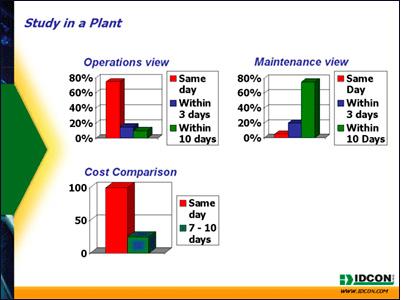http://www.reliableplant.com/Read/29212/improving-maintenance-new-year
Let's assume you have an average plant and the economy is tight. You can't travel, and you must save money. What should your New Year's resolution be? Here are some suggestions:
1) If you are going to cut maintenance cost, you cannot focus on cost itself but rather on what drives cost. Perhaps use an analogy in safety. You can't just send out a memo or shout "improve safety." You need to fundamentally change the way people behave. Another analogy is energy cost. How would you reduce energy cost? You have to focus on things that save energy and drive that cost such as leaks, insulation, etc. When it comes to maintenance cost, often it is just slashed without considering the effects of that cost cutting. Again, focus on what drives maintenance cost, not the cost itself.
2) Get a common understanding between operations and maintenance on what constitutes good maintenance. I recently worked in a plant that has tried for years to improve reliability. However, when asked what constitutes good maintenance, operations answered that "75 percent of the work is executed the same day," while maintenance answered that "good maintenance is when 4 percent of the work is executed the same day." Plant personnel must sit down and define "what good looks like." Otherwise, you will never be able to drive improvement in the right direction.
3) Only request maintenance jobs to be done today or tomorrow if it is absolutely necessary. This is a principle that makes sense and that most people understand, but few actually do. It is the classic know-do gap. It is also often triggered by not trusting the maintenance department. If it is not submitted as an emergency, it will not be done. In the past, people have started to scream louder and louder to get jobs done. Eventually, everybody is screaming. Managers must take charge and enforce a meaningful priority system.
4) Inspect equipment with detailed look, listen, smell, feel inspections together with a minimum of an infrared gun, flashlight and a stroboscope. There is no way you can plan for next week if you don’t know what is about to break down. Many plants are in a catch-22. "There is no time to do inspections because we have too many breakdowns" is something I hear several times a month. Management has to take charge and break out of this cycle. It will initially cost some additional time that will be saved in both maintenance cost and uptime later. There's no magic formula. It's very simple. Collect the tools, find a craftsperson who is highly skilled and willing to do the inspections, and get going. Detailed documentation is necessary at some point, but it is more important to begin the process.
The above is a good list to start on for the average plant. Most plants do some of this already; however, they just need to improve. There is no capital cost — just the cost for doing repairs that must be done anyway earlier and cheaper.

No comments:
Post a Comment